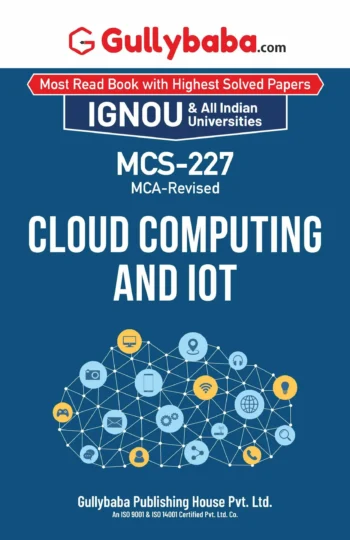IGNOU MCS-227 (January 2024 - July 2024) Assignment Questions
Q1: Define Cloud Computing. List and explain the four categories of cloud deployment models. Differentiate between cluster, grid and cloud computing with respect to its characteristics, physical structure, hardware, resources, applications, networking and scalability features.
Q2: Define resource sharing in cloud computing. What is Tenancy in context of cloud computing? Explain the implementation of single tenancy and multi-tenancy types of resource sharing in cloud computing.
Q3: Define resource pooling in cloud environment. In this context, explain the following:
a. Server Pool
b. Storage Pool
c. Network Pool
Q4: Explain the differences between cloud computing, Fog computing and Edge computing. Draw a block diagram of Cloud-Fog-Edge collaboration and explain all its layers.
Q5: Draw the block diagram of 3-layer architecture of Fog computing and explain all its layers. Also, with the help of a block diagram, explain the 4-levels in Cloud architecture.
Q6: What is a Hypervisor? Compare the functionalities of Type-1 and Type-2 Hypervisors with the help of suitable block diagram for each; also give advantages and disadvantages of each.
Q7: Define virtualization. Explain its underlying abstraction. Also mention the features provided by virtualization environment. Also, describe various Hypervisor based virtualization approaches like full virtualization, para virtualization and hardware assisted virtualization.
Q8: What is Internet of Things (IoT)? What are the characteristics of IoT? List and explain the various components used to implement IoT. Also explain Industrial IoT, Infrastructure IoT and Internet of military things (IoMT) categories of IoT.
Q9: What is scalability in Cloud Computing ? Explain the Proactive Scaling and Reactive Scaling strategies. Also, describe Auto scaling in cloud? Write and explain fixed amount auto scaling algorithm, with the help of a suitable example.
Q10: Explain the following communication protocols with reference to the IoT devices :
i. IPv6
ii. MQTT
iii. CoAP
iv. XMPP
Q11: Define Load Balancing. Explain the following algorithms with reference to load balancing :
a. Static algorithm approach
b. Weighted Round Robin
Q12: Compare Xenserver Vs VMware with respect to the features like Guest O/S support, Backup facility, Thin provisioning, asset management and configuration mapping, dynamic resource allocation and failover, graphics support, licensing, host server management and storage specifications.
Q13: Explain the term VM (Virtual Machine) sizing. Also, discuss the two ways to do VM sizing, give suitable example for each.
Q14: Define a sensor with reference to an IoT device. Explain various characteristics of sensors.
Also, mention and explain all classifications of sensors.
Q15: Briefly discuss any two (for each of the sector) Use Cases of IoT in the following sectors:
(a) Agriculture (b) Transportation
Q16: Discuss the following baseline technologies of IoT:
i. Security in IoT
ii. IoT Analytics
iii. IoT Processors
iv. IoT Standards and Ecosystems
Q17: Explain the following computing components used in laboratories of IoT/Cloud :
a. Arduino
b. Raspberry Pi
Q18: Discuss the following Service Delivery Models of Cloud, with an example for each :
a. Platform as a Service (PaaS)
b. Infrastructure as a Service (IaaS)
c. Software as a Service (SaaS)
Also, explore the features, benefits and relevant use cases for other service models like Security as a Service (SECaaS), Database as a Service (DBaaS), Analytics as a Service (AaaS) and API as a Service (APIaaS).
Q19: “Cloud Computing offers a variety of deployment models, a network connection viewpoint will be used to examine Cloud deployment models and their accessible components.” With reference to this statement, discuss the following types of network connectivity:
a. Public Inter cloud Networking
b. Private Inter cloud Networking
c. Public Intra cloud Networking
d. Private Intra cloud Networking
Q20: Write short notes on the following:
a. Multi homing and its types
b. Horizontal scaling in Cloud environment
c. Challenges in Cloud computing
d. Applications of Edge computing
IGNOU MCS-227 (January 2023 - July 2023) Assignment Questions
Q1: What is Cloud Computing ? How Cloud Computing differs from Cluster Computing , Grid Computing? Explain the characteristics of Cloud Computing. Also, give benefits & applications of Cloud Computing.
Q2: Explain the following types of network connectivity in cloud computing:
1. Public Inter cloud Networking
2. Private Inter cloud Networking
3. Public Intra cloud Networking
4. Private Intra cloud Networking
Q3: Explain the importance of virtualization in cloud computing? How security is achieved through virtualization? Emulation and isolation are important features of virtualization. Justify the statement.
Q4: What is an Hypervisor? Compare the functionality of Type-1 and Type-2 Hypervisor with the help of suitable block diagram for each, also give advantages and disadvantages of each.
Q5: What is Tenancy in context of cloud computing ? Compare Multi-Tenancy model and Single Tenancy model of resource sharing. Explain the various ways through which Multi-Tenancy can be implemented.
Q6: Explain the term Resource Provisioning in context of cloud computing. Also, explain the various approaches used for Resource Provisioning. Discuss the problems of Over-provisioning and Underprovisioning.
Q7: Explain the term Internet of Things (IoT).List and explain the various components used to implement IoT. Give characteristics of IoT. Briefly discuss the following types of IoT:
1. Consumer IoT (CIoT)
2. Industrial IoT(IIoT)
3. Infrastructure IoT
4. Internet of Military Things (IoMT)
Q8: What is Edge computing? Discuss the working of Edge computing. Also, describe the relation between Edge computing, Fog computing and Cloud Computing, with the help of a suitable block diagram ?
Buy MCS-227 Assignment 